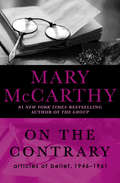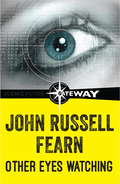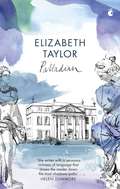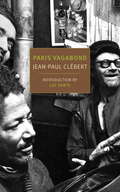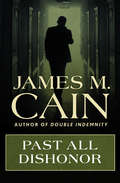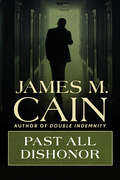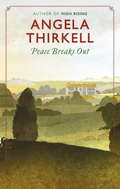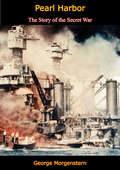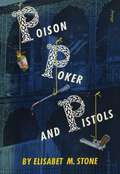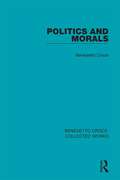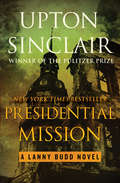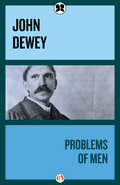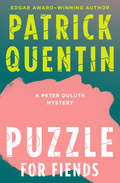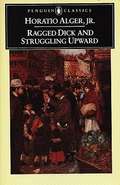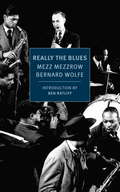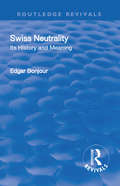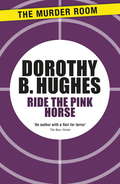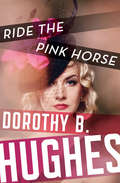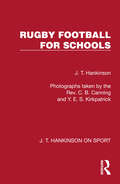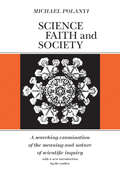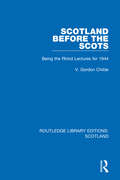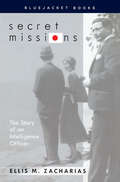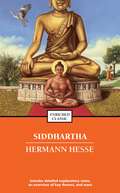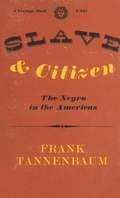- Table View
- List View
On the Contrary: Articles of Belief, 1946–1961
by Mary McCarthyMary McCarthy, one of our most brilliant and beloved authors, serves up wit, insight, and her unique worldview in this diverse collection of essaysIn provocatively titled pieces such as &“The Contagion of Ideas,&” &“Tyranny of the Orgasm,&” and &“No News, or,What Killed the Dog,&” Mary McCarthy expresses her frank, unflinching, often contrarian point of view.Nothing—and no one—is safe from her merciless writer&’s eye—from politics to the ever-changing social scene to the strengths and weaknesses of her native country, where she believes &“passivity and not aggressiveness is the dominant trait of the American character.&” On the Contrary also features a cast of memorable characters. In &“Naming Names,&” Arthur Miller&’s testimony before the House Un-American Activities Committee results in an indictment for contempt of Congress. McCarthy reviews The Human Condition, Hannah Arendt&’s breakthrough book, and despairs of finding a &“really American place&” to take a visiting existentialist—a thinly disguised Simone de Beauvoir? From Dickens to Gandhi to the Kinsey Reports, with pithy and wide-ranging articles on everything from fashion to fiction, the human condition, religion, and sex, On the Contrary raises controversial questions to which, even today, there are no easy answers.This ebook features an illustrated biography of Mary McCarthy including rare images from the author&’s estate.
Other Eyes Watching
by John Russell FearnFor is latest invention, physicist Mason Brooks needs financial backing. To this end, he invites his wealthy sister Vera and her fiancé, Dr Douglas Ashfield, to witness a demonstration. There is an explosion and the experiment goes horribly wrong, and Vera is not only blind but has lost her eyes entirely. Then, to restore her sight, Vera undergoes a dangerous surgical experiment which results in plunging all three of them into an astonishing web of mystery and intrigue...
Other Eyes Watching
by John Russell FearnFor is latest invention, physicist Mason Brooks needs financial backing. To this end, he invites his wealthy sister Vera and her fiancé, Dr Douglas Ashfield, to witness a demonstration. There is an explosion and the experiment goes horribly wrong, and Vera is not only blind but has lost her eyes entirely. Then, to restore her sight, Vera undergoes a dangerous surgical experiment which results in plunging all three of them into an astonishing web of mystery and intrigue...
Palladian (Virago Modern Classics #361)
by Elizabeth TaylorIntroduced by Neel Mukherjee'All her writings could be described as coming into the category of comedy. Comedy is the best vehicle for truths that are too fierce to be borne' Anita Brookner'Elizabeth Taylor has an eye as sharply all-seeing as her prose is elegant - even the humdrum becomes astonishing when told in language that always aims for descriptive integrity, without a cliché in sight. As a result, Taylor excels in conveying the tragicomic poignancy of the everyday' Daily TelegraphWhen newly orphaned Cassandra Dashwood arrives as governess to little Sophy, the scene seems set for the archetypal romance between young girl and austere widowed employer. Strange secrets abound in the ramshackle house. But conventions are subverted in this atmospheric novel: one of its worlds is suffused with classical scholarship and literary romance, but the other is chaotic, quarrelsome and even farcical. Cassandra is to discover that in real life, tragedy, comedy and acute embarrassment are never far apart.
Paris Vagabond
by Jean-Paul ClebértAn NYRB Classic Original Jean-Paul Clébert was a boy from a respectable middle-class family who ran away from school, joined the French Resistance, and never looked back. Making his way to Paris at the end of World War II, Clébert took to living on the streets, and in Paris Vagabond, a so-called "aleatory novel" assembled out of sketches he jotted down at the time, he tells what it was like. His "gallery of faces and cityscapes on the road to extinction" is an astonishing depiction of a world apart--a Paris, long since vanished, of the poor, the criminal, and the outcast--and a no less astonishing feat of literary improvisation: Its long looping breathless sentences, streetwise, profane, lyrical, incantatory, are an adventure in their own right. Praised on publication by the great novelist and poet Blaise Cendrars and embraced by the young Situationists as a kind of manual for living off the grid, Paris Vagabond--here published with the starkly striking photographs of Clébert's friend Patrice Molinard--is a raw and celebratory evocation of the life of a city and the underside of life.
Past All Dishonor
by James M. CainA Confederate spy risks his life to win the heart of a fallen womanEarly in the Civil War, the Confederacy sends Roger Duval to Sacramento, to keep an eye on the situation in California in hopes of turning the Western territory towards the Southern cause. It&’s a plush assignment, well out of the line of fire, but Duval hasn&’t been there long before he comes into mortal danger. On a swim in the Sacramento River, he gets knocked on the head by a paddleboat, and is drowning in the muck when Morina, a quick-witted woman of the night, tosses him a rope. Suffocated by instant, irresistible love, Roger follows Morina to her home turf: Virginia City, Nevada. For the miners, gamblers, and gunfighters who populate this hardscrabble town, her price is negotiable. But for a man in love, she charges a thousand dollars. Roger will sacrifice body, mind, and soul to get that money—but will his sacrifice be enough to make her love him?
Past All Dishonor
by James M. CainA naïve young man follows a fallen woman to a Nevada mining town and risks his life to win her: “Entertaining . . . Cain [has a] flair for realistic detail.” —The New York TimesEarly in the Civil War, the Confederacy sends Roger Duval to Sacramento to keep an eye on the situation in California in hopes of turning the Western territory toward the Southern cause. It’s a plush assignment, well out of the line of fire, but he hasn’t been there long before he comes into mortal danger.Duval nearly drowns in the Sacramento River but is saved by Morina, a quick-witted sex worker, who tosses him a rope. Suffocated by instant, irresistible love, Roger follows Morina to Virginia City, Nevada. For the silver miners, gamblers, and gunfighters who populate this hardscrabble town, her price is negotiable. But for a man in love, she charges a thousand dollars. Roger will sacrifice body, mind, and soul to get that money—but will any sacrifice be enough to make her love him?“A classic.” —Newsweek “[Cain is] one of the greats of American noir.” —The Guardian
Peace Breaks Out (Virago Modern Classics #374)
by Angela Thirkell'You read her, laughing, and want to do your best to protect her characters from any reality but their own' New York TimesIt is 1945. When peace breaks out at last, familiar wartime routines are interrupted, and the residents of Barsetshire seem as disconcerted as they are overjoyed. As the country's eligible young men return home, life regains momentum: before long, everyone is spinning in a flurry of misunderstandings and engagements. The older generation, though, sees that the world will never be the same again.Both wry and poignant, Peace Breaks Out was written in the tumultuous year in which it is set. It is an unforgettable portrait of the joy and misgivings felt in the final days of the Second World War.
Pearl Harbor: The Story of the Secret War
by George MorgensternFirst published in 1947, Pearl Harbor: The Story of the Secret War is widely regarded as the first Revisionist book about the attack on Pearl Harbor on December 7, 1941, and the complex history which preceded and followed it.Although it drew both criticism and praise on its initial release, this book covers many aspects of that war, its antecedents and its consequences, and ranks among the best of the numerous volumes published on the subject.“Those who object to historical skepticism may complain that my book is no contribution to the political canonization of its central figure. That is no concern of mine. As to the purpose my book is intended to serve, some observations from the minority report of the Joint Congressional Committee which investigated the Pearl Harbor attack are pertinent: ‘In the future the people and their Congress must know how close American diplomacy is moving to war so that they may check in advance if imprudent and support its position if sound ... How to avoid war and how to turn war -- if it finally comes -- to serve the cause of human progress is the challenge to diplomacy today as yesterday.’“—George Morgenstern
Poison, Poker and Pistols
by Elisabet M. StoneMargaret Slone doesn&’t like being called Maggie, so that&’s exactly what her city editor calls her. Wise-cracking, quick-tempered Maggie has a nose for news and a finely developed faculty for finding trouble which begin to operate simultaneously when Ned McGowan, a brilliant physician and notorious philanderer, is found dead in his hotel room. The medico claimed that the victim had been dead for at least fifteen hours as rigor mortis was advanced. But Maggie knows differently; she had talked to Ned a mere seven hours before.This strange, unsolved murder catapults Maggie off on a round of combined news-hawking and detection that takes her all over New Orleans and deep into the bayous. There is a great maze of mystery surrounding Ned McGowan&’s life, further complicated by his many women—enigmatic Lili Cheng, wealthy Marta Dellman, Lucille, the nurse, and Olivette, not to mention Maggie&’s own sister, Vangie, who becomes so suspect she&’s jailed by the fumbling Detective Beton.In her quest to get to the bottom of the mystery, Maggie stumbles across the body of a beautiful young woman in the gloom of an old French Quarter house. Close on the heels of this gruesome discovery, she is more perplexed than ever by the sudden disappearance of a second young woman and the shooting of a man seemingly as far removed from the case as he is from the moon. Peppery Maggie Slone must talk her way into trouble and out again to clear her sister&’s name and get the real story behind a completely baffling murder case.
Politics and Morals (Collected Works)
by Benedetto CroceOriginally published in 1946, this book reveals Croce’s dynamic conception of liberty, liberalism and the relation of individual morality to the State. The State which he discusses is more than a national government; it is a historical conception which takes in all ‘states’ - local and international. The volume provides an inspired analysis of the relation of politics and morals, individual liberty, free enterprise and pragmatic social judgement.
Presidential Mission (The Lanny Budd Novels #8)
by Upton SinclairAmerica is at war, and Lanny Budd risks life and limb from North Africa to Moscow on behalf of the Allied cause in this &“absorbing&” historical novel (The New York Times). Members of the German high command believe that American art expert Lanny Budd is sympathetic to their cause, but since 1938 he has been an undercover agent working for President Franklin Roosevelt. Now, in 1941, the United States has been pulled into the fray by the Japanese attack on Pearl Harbor, and Lanny&’s services are required more than ever. In Algiers he must convince the French troops to stand with the Allies in advance of the Axis invasion. A meeting in Moscow, intended to sway Communist despot Joseph Stalin, precedes Hitler&’s disastrous decision to invade Russia. Over the course of the next two years, Lanny faces death at virtually every turn as his important presidential missions carry him from the sands of the African desert to the bomb-blasted streets of Berlin. Presidential Mission is the electrifying eighth chapter of Upton Sinclair&’s Pulitzer Prize–winning dramatization of twentieth-century world history. An astonishing mix of adventure, romance, and political intrigue, the Lanny Budd Novels are a testament to the breathtaking scope of the author&’s vision and his singular talents as a storyteller.
Problems of Men
by John DeweyAlthough primarily addressed to the general reader, the introduction and the last chapters of this work strike straight at reactionary philosophers who obstruct the philosophers who are honest searchers for wisdom.
Puzzle for Fiends: A Peter Duluth Mystery (The Peter Duluth Mysteries #5)
by Patrick QuentinIn this “bright, amusing addition to this series” by an Edgar Award winner, sleuth Peter Duluth faces his greatest challenge: remembering who he is . . . (Kirkus Reviews). Patrick Quentin, best known for the Peter Duluth puzzle mysteries, also penned outstanding detective novels from the 1930s through the 1960s under other pseudonyms, including Q. Patrick and Jonathan Stagge. Anthony Boucher wrote: “Quentin is particularly noted for the enviable polish and grace which make him one of the leading American fabricants of the murderous comedy of manners; but this surface smoothness conceals intricate and meticulous plot construction as faultless as that of Agatha Christie.” When Gordy Friend wakes up in the hospital, he’s got a broken arm, a broken leg, and apparently a broken head, since he can’t remember anything that’s happened before now. Luckily, Gordy learns he has a doting mother, a loving sister, and an absolute knockout wife to care for him and remind him of his lavish, hedonistic lifestyle. He’s also in line to inherit a great deal of money from his recently deceased father—if the will isn’t contested by some killjoys who think Gordy isn’t up to snuff. Then, his trip down easy street hits the skids as Gordy realizes not everything around him is what it seems, and that his father’s passing might not have been so peaceful. Plus, he’s got some weird thoughts clanking around his head—strange memories about the bright lights of Broadway and a beautiful starlet. The more Gordy finds out about himself, the more he suspects that his entire life might be a lie. And that the lie might just kill him . . .
Ragged Dick and Struggling Upward
by Alger Horatio Jr.From the 1860's through the 1890s, Horatio Alger wrote hundreds of novels to teach young boys the merits of honesty, hard work, and cheerfulness in the face of adversity. The hero of Ragged Dick is a veritable "diamond in the rough"-as innately virtuous as he is streetwise and cocky. Immediately popular with young readers, the novel also appealed to parents, who repsonded to its colorful espousal of the Protestant ethic. Struggling Upward, published nearly thirty years later, followed the same time-tested formulas, and despite critical indifference it, too, had mass appeal. As Carl Bode points out in his introduction, Horatio Alger filled a void in American literature and met scant competition both in the nature and the number of his works. Like his heroes, Alger rose to the top by chance, coincidence, and hard work. .
Really the Blues
by Bernard Wolfe Ben Ratliff Mezz MezzrowMezz Mezzrow was a Jewish boy from the slums of Chicago who learned to play the clarinet in reform school and pursued a life in music and a life of crime. He moved from Chicago to New Orleans to New York, working in brothels and bars, bootlegging, dealing drugs, getting hooked, doing time, producing records, and playing with the greats, among them Louis Armstrong, Bix Beiderbecke, and Fats Waller. Really the Blues, the jive-talking memoir that Mezzrow wrote at the insistence of, and with the help of, the novelist Bernard Wolfe, is the story of an unusual and unusually American life, and a picture of a man who moved freely across racial boundaries when few could or did, "the odyssey of an individualist. . . the saga of a guy who wanted to make friends in a jungle were everyone was too busy making money."
Revival: Its History and Meaning (Routledge Revivals)
by Bonjour EdgarUp to a generation ago, the Swiss citizen lived with a feeling of security in foreign relations which we can hardly credit today. Neutrality has come to be taken so much for granted as the fundamental principle of the Federal constitution, and had been so generally recognized in Europe, that it seemed unthreatened and even inviolable. It blended with the republican and democratic ideal to form a national myth of almost religious sanctity. As the axiom of Swiss foreign policy, it had certainly suffered attack both in theory and in fact, but since such crises had always been successfully overcome, Switzerland’s faith in the inviolability of her neutrality had merely been confirmed. It was as if the country were girdled with high, protecting ramparts, behind which its people could go about their lawful occasions unmolested. It was in this period of calm in Switzerland’s foreign relations that international law assiduously sought a formula for the theory of neutrality.
Ride the Pink Horse (Murder Room #467)
by Dorothy B. HughesIt's carnival time in Santa Fe, and three out-of-town visitors are drawn together in the heat, the smells and the colour of the festival . . Sailor, a hood from Chicago, is there to confront his boss, Sen, a crooked politician, to try to get money for what he knows about the murder of Sen's wife, killed supposedly during a robbery gone wrong.Following them both is Mac, a man from the same side of the tracks as Sailor, but who has made very different choices. He's a cop now, and wants Sailor to testify against Sen and put him away.The three strangers collide, retreat and advance through the streets of New Mexico, moving ever closer to a charged and unexpected outcome . . .
Ride the Pink Horse (Murder Room Ser.)
by Dorothy B. HughesDuring the annual Fiesta, three desperate men converge in a perilous New Mexico town in this &“extraordinary&” crime novel (The New Yorker). It takes four days for Sailor to travel to New Mexico by bus. He arrives broke, sweaty, and ready to get what&’s his. It&’s the annual Fiesta, and the locals burn an effigy of Zozobra so that their troubles follow the mythical character into the fire. But for former senator Willis Douglass, trouble is just beginning. Sailor was Willis&’s personal secretary when his wife died in an apparent robbery-gone-wrong. Only Sailor knows it was Willis who ordered her murder, and he&’s agreed to keep his mouth shut in exchange for a little bit of cash. On Sailor&’s tail is a cop who wants the senator for more than a payoff. As Fiesta rages on, these three men will circle one another in a dance of death, as they chase truth, money, and revenge.
Rugby Football for Schools (J. T. Hankinson on Sport)
by J. T. HankinsonOriginally published in 1946, this companion volume to the author’s cricket book deals with rugby football coaching and practice in schools. It is written by a schoolmaster, it was produced in a school, and a unique feature is that the action photographs are of boys who were at that time in the school teams. The author had been coaching rugby football of all grades, Junior Games, House Games, and First XV teams for about twenty years and was at the time of publication in charge of rugby football at Canford School. In this book his methods are analysed in a style likely to appeal to readers of all ages.The book opens with descriptions of the basic arts, passing, kicking, tackling, etc., required by all players, after which the play and tactics of each position on the field are analysed. A specially interesting chapter is that on the principles underlying the scoring of tries and countering defence. Other chapters deal with captaincy, team and positional practice, coaching, school organisation, how to watch a match, and notes on some of the rules.The book is illustrated by more than eighty magnificent action photographs. The choice of the shots is excellent and the efficiency with which the boys carried them out showed how well Mr Hankinson had been able to impart his teaching.While this book was primarily for schools, the instructional detail and the attractiveness of the photographs would also have appealed to more mature rugby players and the book was strongly recommended to all those who are interested in the game. Today it can be enjoyed in its historical context.
Science, Faith and Society
by Michael PolanyiIn its concern with science as an essentially human enterprise, Science, Faith and Society makes an original and challenging contribution to the philosophy of science. On its appearance in 1946 the book quickly became the focus of controversy. Polanyi aims to show that science must be understood as a community of inquirers held together by a common faith; science, he argues, is not the use of "scientific method" but rather consists in a discipline imposed by scientists on themselves in the interests of discovering an objective, impersonal truth. That such truth exists and can be found is part of the scientists' faith. Polanyi maintains that both authoritarianism and scepticism, attacking this faith, are attacking science itself.
Scotland Before the Scots: Being the Rhind Lectures for 1944 (Routledge Library Editions: Scotland #6)
by V. Gordon ChildeOriginally published in 1946, this book presents in what can arguably be described as an unusual way, a slice of Scottish social life by applying to prehistory the principles of Marxism as practised by Soviet scholars of Russian prehistory. Using archaeological evidence, the author distinguishes 6 stages – from the earliest definable groups of immigrants to the Iron Age. There are 10 appendices, devoted to the typology and classification of tombs, pottery, implements and fortifications.
Secret Missions
by Ellis M. ZachariasAn instant bestseller when it was first published in 1946, this memoir recounts the author's nearly forty years of service in naval intelligence, beginning in 1908. One of the first to venture into the realm of psychological warfare, Ellis Zacharias was awarded the Legion of Merit with two gold stars for his contributions. Among the highlights of his impressive career was the role he played in convincing the Japanese to accept surrender in 1945, a subject he deals with in fascinating detail in this book.Zacharias gives readers access to rare psychological profiles that he prepared for the Office of Naval Intelligence on leading political and military figures in Japan. His book also recounts his exploits as a young naval attaché with the U.S. Embassy in Tokyo in the early 1920s. In the early months of the war readers join him in the thick of combat in the Pacific, first aboard a cruiser under his command and later in a battleship. Of particular interest are descriptions of his one-man radio broadcasts beamed at Japan between V-E and V-J days that received kudos from Adm. Ernest J. King for helping bring about the surrender.
Siddhartha: Eine Indische Dichtung (Enriched Classics)
by Hermann HesseThis allegorical novel, set in sixth-century India around the time of the Buddha, follows a young man on his search for enlightenment. THIS ENRICHED CLASSIC EDITION INCLUDES: A concise introduction that gives the reader important background information A chronology of the author's life and work A timeline of significant events that provides the book's historical context An outline of key themes and plot points to guide the reader's own interpretations Detailed explanatory notes Critical analysis, including contemporary and modern perspectives on the work Discussion questions to promote lively classroom and book group interaction A list of recommended related books and films to broaden the reader's experience
Slave and Citizen
by Frank TannenbaumOriginally published in 1947, Slave and Citizen is a classic in the field of comparative slave history and race relations.
